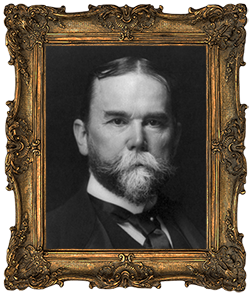The Return of the Old Crossroads Schoolhouse


In the fall of 2017 and for the first time in nearly 80 years schoolchildren returned for studies in the little, forgotten, Monroe Township one-room schoolhouse, commonly known as the Crossroads School. The history of school being taught in this location goes back farther than we have recorded information, and likely took place around the time of the official organization of the county in 1814.
Our county’s histories indicate that the first settlers arrived in what is today referred to as Delaney Bottoms, in Monroe Township, around 1809. They go on to state that school began being taught in this area, (and the rest of the county), just as soon as the hostilities with the Indians came to an end. This is in reference to the American Indians who allied with the British in the War of 1812. Most all of these forces were driven out of the state, by the Indiana Rangers in 1813. Pioneer progress towards civilization of the county resumed immediately thereafter. And most of our county’s pioneers put a high emphasis of importance on educating their children. So we believe sometime shortly after an old log schoolhouse was erected on or very near this exact piece of ground.
According to the Archaeological & Historical Survey of Washington County, published in 1924, concerning Monroe Township’s early schools, it states; “In the 1820s there was a school on the Winslow farm that was used for both school and church, it was called the Second Creek School & Meeting House.”
Under the church history section of this same survey concerning Monroe Township, it states; “The Second Creek School & Meeting House, which was open to all denominations, is probably the oldest church in this area, although deeded in 1830, worship here occurred much earlier than it is thought.”
Undoubtedly, this would have been the first schoolhouse erected in Delaney Bottoms. Many of Monroe Township’s early pioneer children in this area would have garnered their limited education here, from the same location, now occupied by the Crossroads Schoolhouse. Some of the pioneer families that located in this area were; of course the Winslows, and the Hattabaughs, Houshs, Dennys, Westons, Ewings, Arnolds, Earlys, Warriners, Shields, Robinsons, Nicholsons, Callaways, Peughs, Williams and others.
Eventually, the first log structure used here was replaced with another hand-hewn, log cabin building around the time of the land deed. It was then replaced by the frame structure still standing today, shortly after the Civil War. This new and improved, one-room schoolhouse opened for the fall semester to students around 1869.
Through extensive historical investigation, I believe the name of the Second Creek School disappeared sometime prior to the Civil War, when most of the religious denominations in Delaney Valley had built their own church houses. It garners no mention in the 1884 or the Centennial History of Washington County, and we have no additional accounts of it in our archives. My suspicion is that it picked up the “Crossroads” moniker after the Baptist had established their “Crossroads Church,” very nearby, in 1845; and eventually the Second Creek Schoolhouse name was lost to history.
Regardless of the name, children from 6 to 16 years of age, from the Delaney Valley, received their education in this location for well over 100 years. The final school bell rang at the beginning of summer, in 1939, when it was consolidated with the Monroe Township School. The resonance of a century’s worth of children’s voices, laughter, and tears were left abandoned, sitting forgotten on the edge of a corn field.
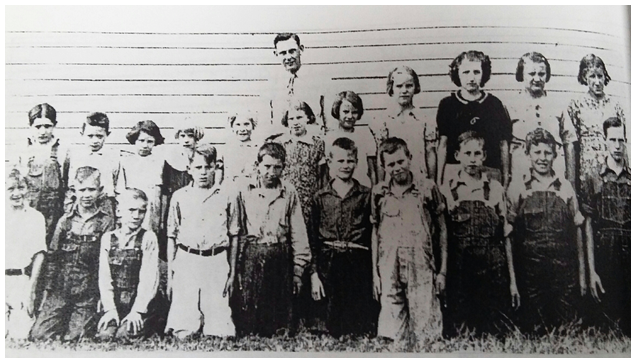 Photo of the final year (1939) at the old Crossroads Schoolhouse, donated by Ron Ewing, pictured 4th from right in the first row.
Photo of the final year (1939) at the old Crossroads Schoolhouse, donated by Ron Ewing, pictured 4th from right in the first row.
Absent from the above photo, local Salem resident, Romie Early, spent the first 18 years of his life in Delaney Bottoms and attended the Crossroads School, until the fourth grade, when the students were consolidated into the Monroe Township School. Romie graciously recounted some of his childhood memories, with me recently, from this time. He said,
“I was born in 1927 and lived in the bottoms until I joined the Army at 18. Growing up, back then no one in that area had running water or electricity. To bathe, we either had to fill buckets from the well to fill a tub, or more often, we just went down to the creek after supper to bathe. It was still that way down there when I left for the Army.”
Romie recollected before he was old enough to attend school, there was a teacher at Crossroads, named Daniel W. Radcliff, who would come down the knobs in his horse and buggy and store them both in Mr. Early’s father’s barn. He’d then walk over to the school, teach his lessons, and return for the horse and buggy at the conclusion of the school day. (This Daniel Westley Radcliffe, 1877-1949, taught school in Washington County for over 45 years.)
Mr. Early then remembered how when he attended school,
“There were no hacks or school buses in the bottoms, so everyone walked to school, some from as far as 2 miles away, like some of the Payne kids. The first teacher I remember having was Mrs. Geneva (Denny) Radcliff, 1911-2007. Now this was an old-fashioned school that was taught the old-fashioned way. For water, every morning the teacher would send a few of us kids down to the Louis Winslow farm, with buckets, to collect water for the day, from their water well, which was a good one. Then we would slosh our way back to the school and poor what was left of the water into a big drinking cooler. There was never any kind of playground equipment at the school, so we had to invent games and things to entertain ourselves. Thankfully there was a woods across the street, so we frequently played hide-and-seek or dog-and-fox, where the girls were the foxes and the boys were the dogs who had to hunt them. We had outhouses for restrooms and every Halloween someone would come at night and turn them over. There was usually always 25 to 30 kids in the schoolhouse, from grades 1 through 8, but like I said, it 1939 the school was abandoned when we consolidated with the Monroe Township School.”
The old building was eventually consumed into the John Woolman Winslow homestead farm and was used as an outbuilding. The pioneer John Woolman Winslow, settled on this property in 1814, when he & his wife, Phoebe Lacy, migrated here from Randolph County, North Carolina. The Winslow farm passed down through the family to John’s great-grandson, Ivor G. Winslow, who passed away in 1992.
While Ivor was farming this land, he often used the old schoolhouse as a place to strip tobacco, and he sometimes even stored grain and feed in the old classroom.
The isolated location and thinly populated area has likely helped to protect the old building from having to endure much in the way of vandalism through the years. But an old piece of neighborhood gossip says that one of the previous owners had threatened to burn the old building down for a while. Thankfully this plan never came to fruition and eventually the farm passed from the Winslow’s to an Amish family. A small community of Amish sprang up in this area in the late 1970s that lasted through the early part of the 2000s. The Amish family that lived on the old Winslow farm stayed until their patriarch unexpectedly passed away, and then relocated back to their home of origin.
Some years later, Rueben & Delilah Byler, (originally of Berne, Indiana), owners of a nice farm in the New Philadelphia Amish Community, were looking for a new farm, (with more property), purchasing the old Winslow homestead in 2012. This farm of course included the old dilapidated Crossroads Schoolhouse.
The abandoned Crossroads Schoolhouse in 2013
Shortly after the Byler family purchased this property, I was afforded the opportunity to look inside and snap a few photos of the historic, old structure, (such as the two pictures above). To be honest, I personally wondered, if I was documenting the existence of a building that would soon be erased from our county’s history, even as Rueben was discussing the possibilities of restoring it with me at the time. Just my own natural skepticism, I guess.
View from the Crossroads School
One of the first things I noticed was the remarkable view! It would have been an ideal location for a nice home, but perhaps the pioneers who established the location thought the view would be inspirational to the young minds contained within it’s walls. As you can see it certainly inspires daydreaming:)
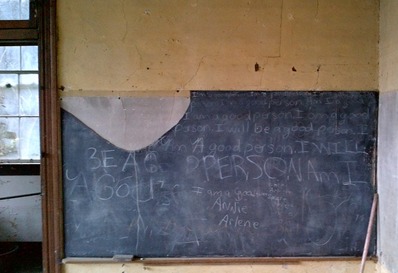 Original Chalkboard from the Crossroads SchoolThe interior of the building was largely all still there and firmly intact, but void of the schoolhouse accoutrements. The old horsehair, plaster walls were in surprisingly good shape, but for practical purposes, would probably need repair or replacement. The same could be said for the windows, which one naturally assumes would be busted out of an abandoned old building, but were only missing two sashes here. You could clearly see where the giant slate chalkboards had once hung along the center of three of the interior walls, but there was only one left and part of it was missing. Apparently little Annie Arlene, whomever she might be, was struggling with being a good person on the day this was written on the remaining board.
Original Chalkboard from the Crossroads SchoolThe interior of the building was largely all still there and firmly intact, but void of the schoolhouse accoutrements. The old horsehair, plaster walls were in surprisingly good shape, but for practical purposes, would probably need repair or replacement. The same could be said for the windows, which one naturally assumes would be busted out of an abandoned old building, but were only missing two sashes here. You could clearly see where the giant slate chalkboards had once hung along the center of three of the interior walls, but there was only one left and part of it was missing. Apparently little Annie Arlene, whomever she might be, was struggling with being a good person on the day this was written on the remaining board.
The floors, which were carefully laid diagonally for improved stability, were still in great condition, just covered in a couple of inches of filth and grime. The interesting, homemade creek-stone, cement foundation, also seemed to be remarkably void of flaws, other than a few unwanted access holes to fill-in. Of course, the old wood stove had long since been removed and the fireplace was crumbling down; so you could add no heat and chimney repairs to the list of concerns with the old structure.
Reuben informed me that he had asked around and there wasn’t anyone left in the immediate area that had ever attended the Crossroads School, but several older people remembered that their parents had gone there. So, by this time, a real history of the place was all but unknown. I left that day with high hopes that Reuben really would restore this old gem in the Delaney Valley and rescue a small piece of our county’s educational history.
However, once Reuben and his family dove into the repairs and rehabilitation of the old house, barns and outbuildings of the farm they purchased, the restoration of the old schoolhouse seemed to drift further away from a real possibility. But over the past few intervening years several other members of Mr. Byler’s family and others from the Amish community have relocated to the Delaney Valley area. This influx caused the real necessity for the creation of a local Amish school, and Reuben already had a school. He and Delilah submitted the necessary paperwork and forms to the State of Indiana to make their school official; and they had already secured a full-time teacher.
Unfortunately, the plans with the teacher fell through. But the State granted their request and encouraged them to have the school open for the Fall Semester of 2017. So a mad rush commenced to rehabilitate the old schoolhouse into something resembling an acceptable and tolerable educational institution for the area’s young Amish children. The vacated teacher’s position fell to Rueben and his wife, Delilah, who have come to cherish the opportunity.
Most of the Amish community in the area pitched in to accomplish the task. The rusted tin roof was patched and repainted. The old plaster was removed from the walls and new drywall put up in its place. They did manage to salvage and restore all of the original woodwork and trim. There was no insulation anywhere in the old building, so that was a quick priority to correct. The old chimney was torn down and rebuilt, (brick by brick), and an old wood stove was secured for their primary heat source.
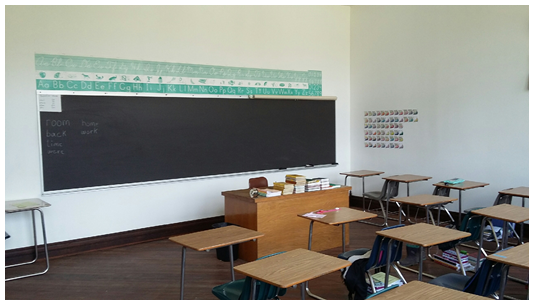
The Eastern School system generously donated desks and chairs from their storage supply and a new chalkboard was secured for placement on the East wall, directly behind the teacher’s desk.
All of the old windows were removed and beautifully duplicated with Sassafras frames and sashes, by an Amish man from the Orleans area, who guaranteed they would last as long as aluminum frames.
Although they were not able to accomplish everything they had hoped for before the school year began, the little old house was again sound, secure and ready for a return to service.
So in the fall of last year, and for the first time in 78 years, the school bell rang once again at the old Crossroads Schoolhouse and classes commenced for 13 students, grades 1 through 8.
Fall weather eventually halted additional restoration efforts, but the Byler’s still plan to repaint the old clapboards and hopefully dig a well for it, which according to our histories, it never had. For nostalgia’s sake, Reuben also hopes to find a pot-belly wood stove and enough antique school-desks to accommodate each student and further compliment the old structure.
The Washington County Historical Society collectively applauds and commends the efforts of Rueben and Delilah Byler, and their family, for the complete resurrection of this nearly extinct artifact of our county’s educational heritage. Generally, most all of the old historic structures in this county, with any kind of rehabilitation issues, get reduced to rubble. So the conscientious effort towards historical preservation displayed in this community is appreciated beyond our ability to express. We wish them all, students and teachers alike, nothing but success! We hope the new/old Crossroads School legacy will continue into the next century!
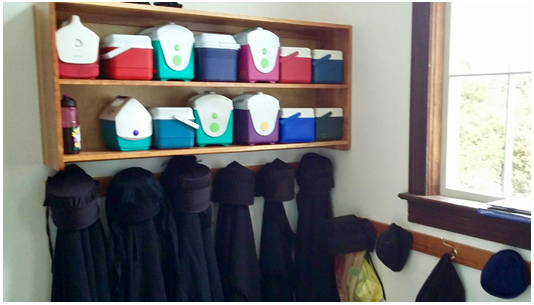 A clash of new and old, much like the story itself, the hats, bonnets and cloaks hang under the brightly colored coolers, awaiting the young student’s lunch break.
A clash of new and old, much like the story itself, the hats, bonnets and cloaks hang under the brightly colored coolers, awaiting the young student’s lunch break.


